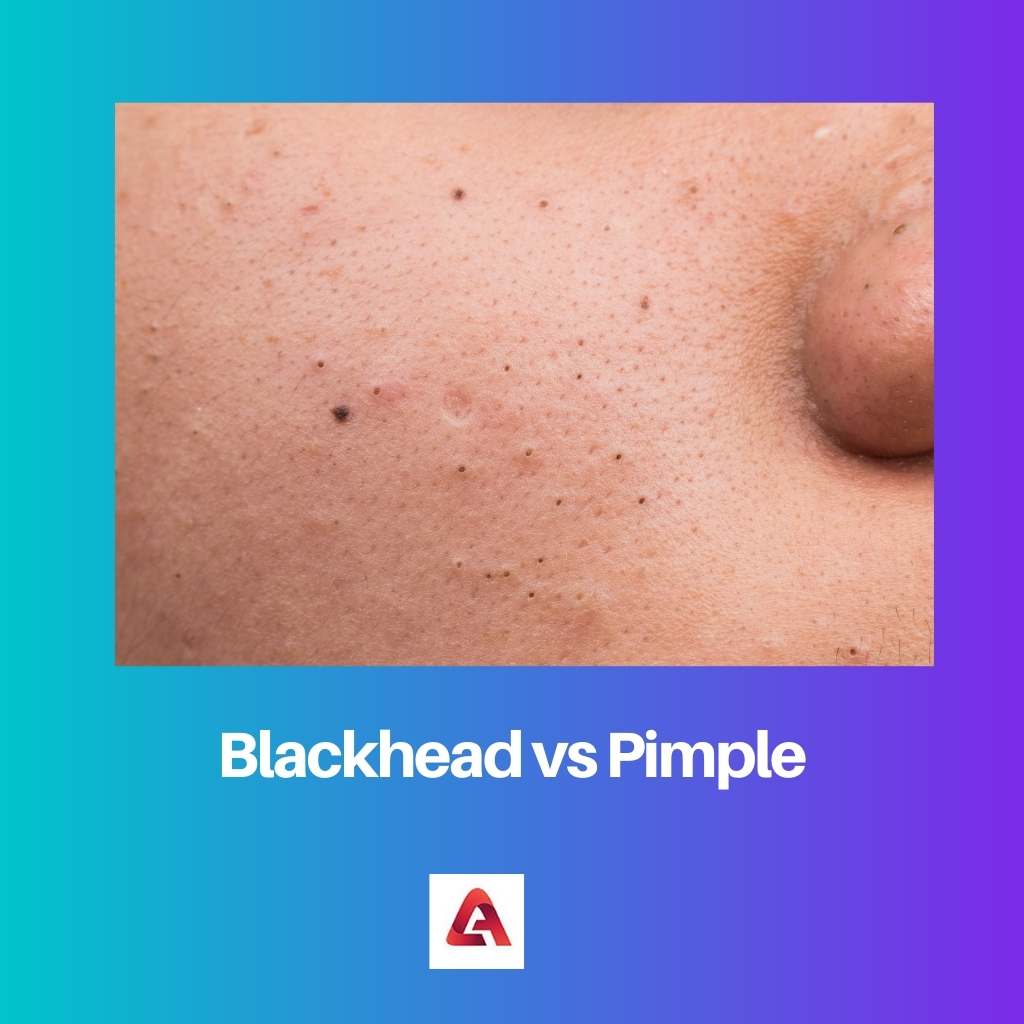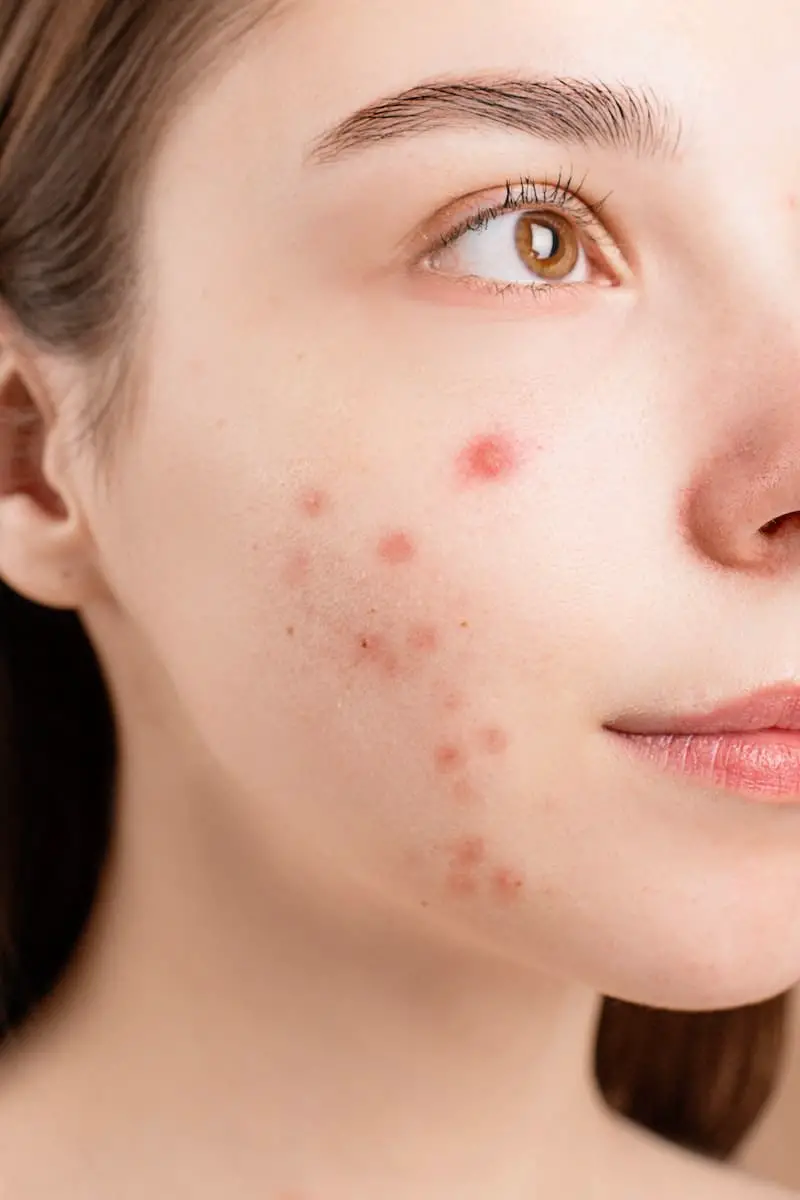Blackheads and pimples are both different types of blemishes or acne. Some people may get confused between them, but they are actually quite different due to their development, appearance, and treatment techniques.
They are very common in teens and adults and may have various causes like hormonal imbalance, stress, etc.
Key Takeaways
- Blackheads are clogged pores that remain open and oxidize, forming a dark color, while Pimples are inflamed bumps caused by blocked pores.
- Blackheads are non-inflammatory and do not cause pain, while Pimples can be painful and tender to the touch.
- Blackheads are easier to treat and prevent than Pimples, which require more specialized treatment.
Blackhead vs Pimple
The difference between a blackhead and a pimple is that a blackhead is a dark brown or black blemish that looks like a black dot, whereas a pimple is reddish in appearance and may sometimes have a white top due to it being filled with pus.

Blackheads are hair follicles that get blocked or clogged due to dead skin cells or oils found on the skin. They are non-inflammatory and can not be filled with pus.
They are most commonly found right on the surface of the skin. They are flat or may appear as slightly raised black dots.
On the other hand, pimples are clogged hair follicles that get infected due to exposure to bacteria. They can very easily be inflamed and cause irritation or even pain.
They tend to sometimes have a white head due to the presence of pus in the lesions. They are most commonly found underneath the surface of the skin.
Comparison Table
| Parameters of Comparison | Blackhead | Pimple |
|---|---|---|
| Color | Dark brown or black | Red or white |
| Shape | Slightly raised black dots. | Usually swollen and red lesions that may be filled with pus. |
| Development | A hair follicle becomes either clogged or plugged. | A clogged pore becomes infected with bacteria. |
| Treatment | Gentle extractions or pore strips. | Over-the-counter medication like benzoyl peroxide. |
| Placement | On the surface of the skin | Under the skin’s surface. |
| Pus | It can not be filled with pus. | It can have pus-filled in the lesions. |
| Inflammation | Non-inflamed. | They can be inflamed. |
What is Blackhead?
Blackheads are clogged hair follicles that look like black dots appearing just on the surface of the skin. The most common places for their appearance include the face, shoulders, back, and sometimes even your chest. Some people consider them a mild form of acne.
A more scientific name for a blackhead is open comedo. They are so tiny that you can barely see them. But sometimes, in rare cases, they can become several millimetres in diameter, which makes them large.
The formation of blackheads occurs when a hair follicle gets clogged. Sometimes cells and oil on the skin can collect on a follicle’s opening, leading to a bump formation.
If the skin found over it opens, it can be exposed to air which will cause it to look black, forming a blackhead.
Since they are found on the skin’s surface, people can gently remove them through an extraction done by an esthetician or even themselves.
One of the most common ways to remove them is by using pore strips, but the results achieved through this method are temporary.
Other blackhead treatments include salicylic acid, topical retinoids, glycolic acid, non-comedogenic moisturizers, etc. Blackheads are considered the first stage of acne.
They have the ability to further develop into a pimple if they get infected by bacteria.

What is Pimple?
A pimple is also known as an acne papule. They are reddish bumps found on your skin. They may be inflamed and may also develop a pus-filled top that will be white or yellow in color.
If a pimple gets filled with pus, it is known as an acne pustule. Some people know a pimple as a ‘whitehead.’
Acne occurs whenever hair follicles get clogged or plugged with dead skin cells and oils. If this clogged pore becomes infected with bacteria, it forms a pimple which can appear as a reddish bump that may sometimes have pus.
A lot of people tend to use home remedies when it comes to treating pimples, but over-the-counter medications targeted towards acne work the best.
You may even get prescription acne medications from a dermatologist. These treatments may include Benzoyl peroxide, topical antibiotics, oral antibiotics, etc.
Some pimples may get inflamed and irritating. In these cases, it is recommended never to pop a pimple since it may lead to scarring, which causes long-term acne scars.
There are things you can do to prevent pimples. These include properly washing your face, using a non-comedogenic moisturizer, staying hydrated, limiting your makeup, not touching your face, limiting sun exposure, using proper sunscreen, avoiding certain trigger food like chocolate, etc.

Main Differences Between Blackhead and Pimple
- A blackhead tends to be either dark brown or black in color, whereas a pimple is red or white if it has any pus.
- Blackheads lie flat but are slightly raised and have a black dot-like appearance. On the other hand, pimples are swollen red lesions that appear white if they are filled with pus.
- A blackhead is formed when a hair follicle becomes clogged or plugged, which shows up as a black blemish, whereas a pimple is formed when a clogged pore becomes infected with bacteria.
- To treat a blackhead, it’s recommended to get gentle extractions done, do them yourself, or use pore strips. A pimple can be treated with the help of acne medications that can easily be found over the counter, like Benzoyl peroxide, antibiotics, etc.
- A blackhead is placed on the surface of the skin. On the other hand, a pimple is found underneath the skin’s surface.
- A blackhead is never filled with pus, whereas pimples can be filled with pus.
- Blackheads are never inflamed. Pimples, on the other hand, can be inflamed sometimes.

- https://onlinelibrary.wiley.com/doi/abs/10.1046/j.1468-3083.2001.00357.x
- https://www.sciencedirect.com/science/article/pii/S0022202X15442435

It’s quite interesting to know that blackheads are non-inflammatory and never filled with pus, unlike pimples. The treatments and preventive measures for both are also very insightful.
I appreciate the scientific explanations provided for the formation of blackheads and pimples. The section on treatment and prevention is particularly enlightening.
The explanations of the causes and treatments for blackheads and pimples are very helpful. This article is a great resource for anyone looking to understand more about them.
I’ve always had trouble dealing with pimples. The preventative measures mentioned here are something I will definitely be implementing. Thank you!
I didn’t know that blackheads are initially considered a mild form of acne. I learned a lot from this article. Thank you for sharing!
This is an excellent article. I appreciate the clear and concise way the differences between blackheads and pimples are explained.
I have always struggled with differentiating between blackheads and pimples. This article has definitely cleared things up for me. Thank you!
Completely agree. I also found the comparison table very useful in summarizing the key differences between blackheads and pimples.
This is a well-researched article that provides valuable insights to help individuals better understand and manage blackheads and pimples. Thank you for the informative content.
Thank you for this detailed comparison between blackheads and pimples. It was very informative and helpful.
The differences highlighted in the article have made it very easy to distinguish between blackheads and pimples. A very educative piece.